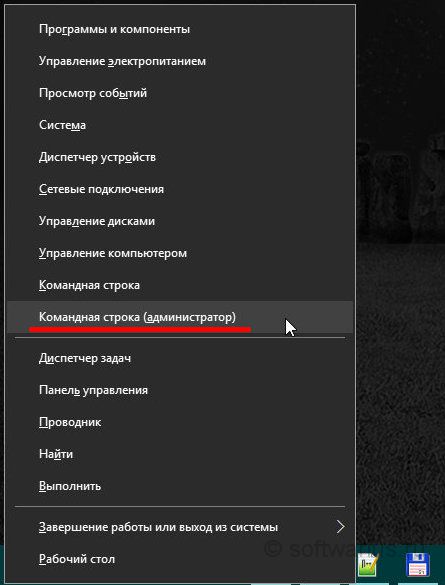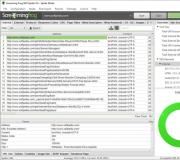Command line as administrator windows 10. How to run command line as administrator. Using the ExecAS tool
In the instructions on this site, every now and then one of the steps is “Run command line from the administrator ". Usually I explain how to do this, but where not, there are always questions related to this action.
In this guide, I will describe how to run the command line as Administrator in Windows 10, 8.1 and 8, as well as in Windows 7. There is also a separate instruction for Windows 10 available on the site :)
In order to run the command prompt with administrator rights in Windows 8.1, there are two main ways (one more, universal method, suitable for everyone latest versions I will describe the OS below).
The first method is to press the Win keys (key with the Windows logo) + X on the keyboard and then select the "Command line (administrator)" item from the menu that appears. The same menu can be called by right-clicking on the "Start" button.

Second launch method:

That, perhaps, is all for this version of the OS, as you can see - everything is very simple.
On Windows 7
To run Command Prompt as administrator in Windows 7, follow these steps:

Instead of searching through all programs, you can enter "Command Prompt" in the search box at the bottom of the Windows 7 Start menu, and then follow the second step above.
Another way, for all latest OS versions
The command line is the usual Windows program(cmd.exe file) and you can run it like any other program.
It is located in the Windows / System32 and Windows / SysWOW64 folders (for 32-bit versions of Windows, use the first option), for 64-bit versions - the second.

Just like in the methods described earlier, you can simply click on the cmd.exe file right click mouse and select the desired menu item to run it as administrator.
There is one more possibility - you can create a shortcut for the cmd.exe file where you need it, for example, on the desktop (for example, by dragging it with the right mouse button on the desktop) and make it always run with administrator rights:

Done, now when you start the command line with the created shortcut, it will always run as administrator.
Certain tasks require elevated commands to be executed. Here are some ways to run Command Prompt (cmd) as administrator.
Start button context menu
Right-click on the Start button (or the keyboard shortcut WIN + X) and select Command Line (Admin) in the opened menu .
Using search in the Taskbar or Start Menu
- Click the search icon on the taskbar or the Start button
- In the search bar, type cmd... Or just start typing cmd after opening the start menu
- In the search results, right-click on the desktop app Command line
- In the menu that opens, select the item Run as administrator

Launching Command Prompt from Explorer
When you need to open the command line at a specific path, you can do this through Explorer.
- Go to desired folder and select the menu File in Explorer
- Move the mouse cursor over the item Open command prompt or click the arrow on the right side of it
- Select item Open Command Prompt as Administrator
Several users often work at one computer, whose rights may differ. Some applications, files and commands require administrator rights to run. In this article, we will look at the main ways of how to run the program as an administrator in various situations.
How to run the program as administrator
Microsoft has foreseen that users will often have to use the function of launching the program as an administrator, so it is implemented as conveniently as possible. Here are some common options for running the application as administrator:

Worth noting: There are some specific applications that can be run as administrator and in other ways. For example, by right-clicking on "Start", in the drop-down menu you can see the option to run the command line as administrator.
How to run the program as administrator always
There are programs that are constantly required to run on behalf of the administrator for competent work. In order not to do this by the methods described above, you can set by default the launch of such applications with the appropriate rights, both for one user and for all.
Running the program as administrator is always for one user
If the user has administrator rights, he can set himself to run the program on behalf of the administrator on a permanent basis. This can be done in the following ways.
Method 1

Option 2

How to run programs as administrator always for all users
If the computer has several users and a certain program is always required to be executed on behalf of the administrator, regardless of user rights, the administrator has the opportunity to make the appropriate settings. To do this, you need to do the following:

After that, you will see that on the "Compatibility" tab, a checkmark is automatically set in the item to run the program as administrator, and it is darkened. This means that the program runs on behalf of the administrator for all users.
Hello my curious readers!
Today in our article we will talk about the command line (cmd.exe) in Windows 10. The command line allows you to perform a variety of tasks that are not always possible to perform through graphical interface... And when working in cmd, elevated rights can often be required. Now we will find out 8 ways how to open cmd with administrator rights in Windows 10... This does not mean that in the rest Windows versions these methods will not work. I personally tested all the methods described below to open cmd with administrator privileges on Windows 10 and they are completely working. If you have Windows 7 or 8, then check them on your system.
So let's go!
1. Launching cmd from the Start context menu
Click on Start with the right mouse button or press the Win + X combination, and the keys are faster, I guarantee this;) A context menu will appear, in which we select the item Command Line (Admin)... Ready!

2. Through the task manager
If you have the Task Manager running, you can open cmd directly from it. To do this, go to the menu File -> Start a new task.

Enter cmd and check the box below Create a task with administrator rights... And then OK.

3. Through the task manager (tricky way)
The third method is very similar to the second, but a little faster and less well-known.
The beginning is the same, that is, in the Task Manager, select File -> Start a new task, but when you click on this item, hold down the key Ctrl... In this case, cmd starts immediately in administrator mode, without further ado.

4. Launch cmd from Windows 10 search
Press the Win + S combination or aim with the left mouse button at the magnifying glass icon to the right of the Start button. In the search field, you can enter either in English ‘ cmd‘Or in Russian enter the first 5-6 letters of the name’ Command line‘. Then right-click on the search result, select Run as administrator.

5. Run cmd from the All Applications menu
Open Start, click on All Applications and find the System Tools - Windows item. Usually it is hidden at the very bottom, so scroll with the mouse wheel to the very end.

So, we found the Utilities group, opened the list of programs inside and found the Command Line. Right-click on it, then Advanced, then Run as administrator.

6. Run from the system directory Windows \ System32
You can run the command line directly from its system32 home folder. To do this, go to Explorer / My Computer, find the C drive, look for Windows folder, go there, find the System32 folder, go deeper and deeper into the rabbit hole, go into it. In the System32 folder, we are looking for the file cmd.exe... We select it. And then there are two options.

The fastest and simplest: right-click on cmd.exe and select the one we already know Run as administrator.

Another option takes a little more time. When you select a file, the inscription Tools for working with applications appears at the top. Click there with the left mouse button, another menu pops up from the bottom, click on Run as administrator.

7. Run cmd from any folder in Explorer
This option for opening the command line is available from any folder in Windows 10 Explorer. Go to the location you need, go to the File menu -> Open command line -> Open Command Prompt as Administrator.

8. Create an admin shortcut for cmd.exe
For quick access to the admin command line, do the following.
On the desktop on free space right-click, select New -> Shortcut.

Enter cmd or cmd.exe, both will work. Further.

Name the shortcut so that it is immediately clear, for example, cmd.exe (admin). Ready.

The shortcut has been created, but not configured yet. We go into its properties (right-click on the shortcut and select Properties). Click the Advanced button ...

... and tick the Run as administrator box. We save the whole thing and now we can always start the cmd command line with administrator rights by simply launching the shortcut.

But you can speed up the launch even more;)
Right-click on the shortcut and select Pin to taskbar. Or Pin to home screen as an option.
I described here exactly those options that allow you to run the command line with admin privileges. There are also ways to launch, but they are on behalf of a regular user, which does not fit into the topic of this article. For example, via Win + R or hold Shift while right-clicking on the application.
As you can see, the same action in Windows can be performed different ways... Depending on the current specific situation, I can choose the most appropriate option for launching cmd.
Did you know all these methods? Or some of them were new?) Tell us in the comments.
Many operating room programs Windows systems 10 will require administrator rights to work properly. Running as administrator allows programs to configure system settings that are not available ordinary user... It is the programs that change system parameters and require administrator rights.
There are many ways to run a program as administrator in Windows 10. In this article, we will look at how to launch the program as an administrator once and how to configure the launch of the program as administrator on all subsequent launches. We will also look at how to run programs from the command line.
Launching the program as an administrator can be done in just a few clicks. The user has only to find the program or the program shortcut on the desktop or in the explorer and select the item in the context menu.
Launching programs pinned to the home screen is done in a similar way. Click on the program icon with the right mouse button and in the item Additionally choose Run as administrator.
And also it is possible to run programs as administrator immediately from Windows search 10. First of all, we find the program in the start menu and select the item in the context menu Run as administrator. 

After that, all subsequent launches of the program will be carried out on behalf of the administrator. All that the user needs to do is make the current settings for all programs, which should be launched only on behalf of the administrator.
You can easily run programs as an administrator from the command line. The whole secret is that the command line must be run as administrator. If you use the command line without administrator rights, the programs will start in the usual way.

Similarly, you can launch any of the programs installed on your computer. With the first command we indicate the path to the program, and with the second command we already indicate the name the desired program... All programs launched from the command line as an administrator are also run as an administrator.
Other ways to run the command line can be found in our. We also recommend that you pay attention to the item how to return the command line to the Win + X context menu on recent builds operating system Windows 10. Since many users, when opening the context menu on the start button, found Windows PowerShell instead of the command line.
conclusions
Running the program as an administrator is required for utilities that change system parameters. We examined how to run a program as an administrator in Windows 10. We also examined how to run programs from the command line as an administrator.



